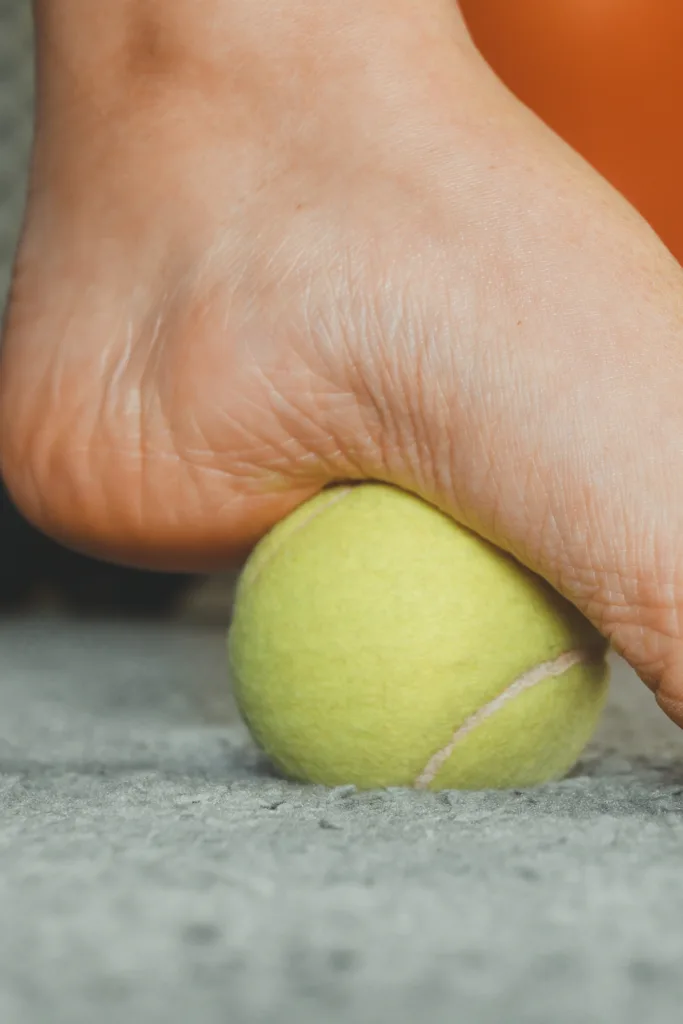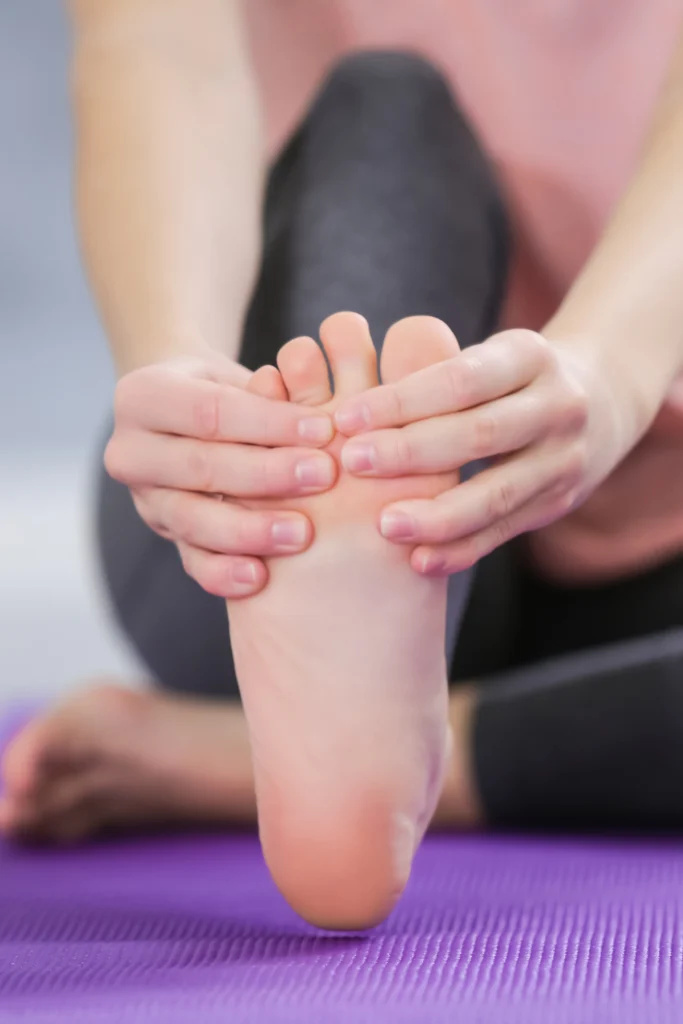Plantar fasciitis is a common complaint from runners – both beginner runners and more advanced runners alike.
Running with plantar fasciitis can seem impossible with chronic heel pain.
Making up 11-15% of foot symptoms requiring professional care, it is estimated that 1 in 10 people will develop plantar fasciitis during their lifetime.
Often referred to as painful heel syndrome or heel spur syndrome, this painful condition doesn’t have to stop you in your tracks.
There are ways to treat it and stop it from coming back for good.
Here’s all you need to know about running with plantar fasciitis.
We’ll look at:
- What is plantar fasciitis?
- What are the symptoms of plantar fasciitis?
- Who is at risk of developing plantar fasciitis?
- How to treat plantar fasciitis
- How to prevent plantar fasciitis
- 4 of the best stretches to help prevent plantar fasciitis
Ready?
Let’s get started!

What is plantar fasciitis?
Your plantar fascia is a thick ligament that runs from your toes to your heels and provides support to the arch of your foot.
The ligament is made of collagen and is not very stretchy.
Plantar fasciitis occurs when the ligament becomes irritated and inflamed, causing pain in the heel.
Running with plantar fasciitis can be painful.
Continuing with exercise if you experience plantar fascia pain can make your symptoms worse.
So it’s important you take a step back and listen to your body and follow the tips in this guide.
Related: IT band syndrome: How to fix it + 7 training mistakes to avoid
What are the symptoms of plantar fasciitis?
Here are some common symptoms of plantar fasciitis.
You may not experience all of these symptoms, but these are the common ones to look out for.
- Heel pain
- Chronic pain beneath the heels
- Pain in the medial side of the heel
- Pain that worsens after a period of inactivity
- Pain that is worse when arising in the morning, and becomes less severe after a few steps
- Pain that worsens at the end of the day
- Pain that worsens following prolonged weight bearing activities
- Tightness in the Achilles tendon
- Tenderness when you flex your toes backwards or stand on your tiptoes.
In rare cases, you may experience pins and needles in the foot and pain that spreads to the whole of the foot including the toes
According to a 2012 study, plantar fasciitis is the most common cause of chronic pain beneath the heel in adults, making up 11-15% of the foot symptoms requiring professional care.
Related: Knee pain after running: Causes + 10 prevention tips

Who is at risk of developing plantar fasciitis?
According to research, plantar fasciitis is more common in middle-aged, obese females and young male athletes.
Adding that obesity is present in up to 70% of patients with plantar fasciitis.
If you overpronate you are also at higher risk of developing plantar fasciitis.
In fact, reports show that 81-86% of patients with plantar fasciitis have excessive pronation.
Overpronation is when the way you walk or run eventually causes the arches of your feet to flatten more than they would normally, putting strain on the muscles in your foot.
You are also at risk of developing plantar fasciitis if you:
- Run in worn out or the wrong type of running shoes
- Constantly run on hard surfaces like concrete or asphalt
- Wear high heels for a lot of the day
- Suddenly increase your mileage
- Neglect to stretch your calf muscles
- Do too many hill workouts and speed intervals.
Related: What is runner’s knee? How to fix it + 6 prevention exercises

How to treat plantar fasciitis
It can take between 6 to 18 months, and sometimes longer, to find a complete resolution to plantar fasciitis.
Early recognition and management of plantar fasciitis often leads to greater chance of success with conservative therapies.
Unfortunately, there are few high quality trials that have been conducted to support more invasive therapies such as shock wave therapy and surgery.
In most patients, conservative treatment is usually sufficient.
A period of rest accompanied with anti-inflammatory drugs (NSAIDs), ice packs, stretching and a shoe insert is recommended.
Here is a list of possible treatments.
#1 Rest
When you start to experience symptoms of plantar fasciitis, such as heel pain, stop running and rest.
If you continue to exercise through the pain, you may make it worse.
Rest and raise your foot until the pain subsides and do some gentle stretching at home.
#2 Ice
Put an ice pack in a towel on the painful area for up to 20 minutes every 2 to 3 hours.
A bag of frozen peas works well if you don’t have an ice pack.
Icing the affected area will help to reduce any swelling and inflammation.
#3 Anti-inflammatory drugs (NSAIDs)
Take painkillers like paracetamol and ibuprofen to help ease the pain.
#4 Stretching
There are a number of stretches that you can do to relieve the symptoms of plantar fasciitis.
These stretches include:
- Standing calf stretch
- Plantar fasciitis stretch
At the end of this guide you will find a breakdown of each stretch.
#5 Massage
There are benefits to using myofascial release (i.e. self massage or foam rolling) to help address the symptoms of plantar fasciitis.
Place a tennis ball or massage ball on the ground and gently roll it under your foot for a few minutes.
This will help to loosen up the plantar fascia ligament, making it much less likely to become irritated.
You may feel some soreness. Stop if you start to feel any pain.
#6 Shoe inserts
Shoe inserts (also known as orthotics) are used to reduce the symptoms of plantar fasciitis by reducing strain in the fascia during standing and walking.
Research has shown that shoe inserts reduce foot pronation, collapse of the longitudinal arch and associated elongation of the foot.
Shoe inserts should be used for a short period of time – up to three months,
There’s no conclusive evidence that shows the success of shoe inserts over a longer period of time (i.e. 12 months or more).
#7 Night splints
Night splints are designed to keep your ankle in a neutral position overnight.
This way you passively stretch your calf and plantar fascia during sleep.
The purpose of a night splint is to allow your fascia to heal.
There is some evidence that shows that night splints are useful in improving symptoms of plantar fasciitis.
It is recommended you use night splints for 1 to 3 months and should be considered if you have been suffering with symptoms for more than 6 months.
#8 Corticosteroid injections
Steroid injections may be a preferred treatment option if conservative treatment hasn’t been successful.
According to research, there is no gold standard when it comes to the types and doses of local injections of corticosteroids.
Interestingly, some studies have shown that there is no difference after 8 weeks between corticosteroid injections and plantar stretching.
However, corticosteroid injections have been shown to significantly reduce plantar fasciitis thickness as early as two weeks and one month following treatment.
This is important because there is a correlation between decreased plantar fasciitis thickness and improvement in symptoms.
It’s worth noting that, according to the same research, corticosteroid injection therapy has short term benefits.
The effectiveness of treatment is not maintained beyond six months.
#9 Shock wave therapy
Shock wave therapy (called extracorporeal shock wave therapy (ESWT)) is another treatment option if all other forms of treatment mentioned above have been unsuccessful.
It works by sending high or low energy sound waves into the skin of the affected area.
Although the exact way it works is not fully understood, it is thought this promotes the formation of new blood vessels within the damaged tissue.
You will normally be given up to three sessions of shock wave therapy before determining if your symptoms have improved.
#10 Surgery
If your symptoms persist for more than 12 months, even after conservative treatment, then you may be selected for surgery.
Plantar fasciotomy is the type of surgery that is conducted to detach your fascia from your heel bone in order to relieve tension.
During the healing process, your ligament experiences new growth, which can encourage the lengthening of your fascia
Related: Hip pain after running: 8 causes + how to fix it

How to keep running with plantar fasciitis
To prevent plantar fasciitis for good, there are a number of measures you can take to stop this painful condition in its tracks.
#1 Run on soft surfaces
Constantly running on hard surfaces like concrete and asphalt is a contributing factor towards the development of plantar fasciitis.
Aim to run on softer surfaces like grass or a treadmill.
#2 Avoid sudden jumps in your training
Aim to keep mileage increases to less than 10% per week.
Sudden leaps in your training have been shown to cause plantar fasciitis and other overuse injuries.
#3 Wear the proper running shoes
Wearing the right pair of running shoes is crucial to help prevent plantar fasciitis.
The best running shoes for you will depend largely on your foot type and running gait.
The key feature to look for in a pair of shoes though is arch support.
If you’re unsure, seek advice from a professional.
Most running shoe shops perform a gait analysis service that will help you spot any issues with your running form.
#4 Strength train
Strength training has many far-reaching benefits.
By strengthening the muscles in your mid-foot with barefoot exercises you will be able to significantly reduce the likelihood of plantar fasciitis recurring or occurring in the first place.
#5 Shorten your stride
Adjusting your stride by shortening it and increasing your running cadence can also help to prevent plantar fasciitis.
#6 Stretch
As mentioned earlier, stretching is a key preventative measure and it’s so simple to implement.
It’s important to stretch the plantar fascia and the Achilles tendon to loosen them up.
In the next section of this guide you will find 4 of the best stretches to prevent plantar fasciitis.
Do stretches first thing in the morning alongside massage and repeat three times during the day.
Related: Lower back pain after running: Causes + 7 ways to prevent it

4 of the best stretches to prevent plantar fasciitis
Here are 4 of the best stretches to treat plantar fasciitis.
#1 Standing calf stretch
- Facing a wall, put both hands on the wall at shoulder height and place one foot in front of the other. The front foot should be approximately 30 cm (12 inches) from the wall.
- With the front knee bent and the back knee straight, bend the front knee towards the wall until the calf in your back leg feels tight.
- Relax and repeat 10 times.
#2 Sitting plantar fasciitis stretch
- Sit down and cross one foot over your knee.
- Grab the base of your toes and pull them back towards your body until you feel a comfortable stretch.
- Hold for 15 to 20 seconds and repeat three times.
#3 Plantar fascia stretch
- Sit down and rest the arch of your foot on a round object, such as a tennis ball or massage ball. If you don’t have either of these, a tin of beans will suffice.
- Roll the arch in all directions for a few minutes.
- Repeat this exercise at least twice a day.
#4 Achilles tendon stretch
- Loop a towel around the ball of your foot and pull your toes towards your body, keeping your knee straight.
- Hold for 30 seconds. Repeat three times on each foot.
Related: Heel pain after running: Causes + 8 ways to prevent it
- 5 things I wish I’d known before returning to running - March 3, 2024
- Running 20 minutes a day: Benefits + how to start - January 27, 2024
- How to run your first 2 hour half marathon - January 16, 2024
